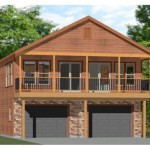How To Find The Floor Plans Of A Building
Acquiring the floor plans of a building can be essential for various purposes, ranging from architectural projects and interior design to property management and historical preservation. The process of locating these plans can vary depending on the type of building, its age, its ownership, and the existence of relevant records. This article provides a comprehensive guide on how to navigate the process of finding floor plans, outlining key resources and strategies for successfully obtaining the desired information.
Understanding the Importance of Floor Plans
Floor plans are scaled diagrams that represent the arrangement of rooms and spaces within a building, viewed from above. Typically, they depict walls, doors, windows, and fixed installations like plumbing fixtures and appliances. The significance of possessing these plans stems from their utility in a wide array of applications. For architects and engineers, floor plans are fundamental for renovation projects, structural analyses, and assessing building compliance with current regulations. Interior designers rely on them for space planning, furniture layout, and visualizing design concepts. Property managers use floor plans for tenant allocation, maintenance planning, and emergency response. Historians and preservationists utilize them to document and understand the evolution of buildings over time. Therefore, obtaining accurate and detailed floor plans can be a critical precursor to a diverse set of undertakings.
Key Resources for Locating Floor Plans
The availability of floor plans is often dependent on the age of the building and how meticulously its records have been maintained. The approach to searching for these plans often involves a multi-faceted strategy, considering various potential sources. Local government offices, archives, online databases, and professional networks are common starting points for locating these documents. Each resource presents its own set of procedures and accessibility guidelines, requiring careful consideration and a strategic approach.
Local Government Offices: City halls, county clerks, and building departments are primary repositories for building-related documents. These offices typically maintain archives of construction permits, zoning records, and original building plans submitted during the construction or renovation of a property. To access these records, it is often necessary to visit the office in person or contact them through their website or phone. Be prepared to provide specific details about the building, such as its address, the name of the original owner or architect, and the approximate year of construction. Some government offices offer online databases where these records can be searched and retrieved digitally. However, others may require a formal request and the payment of a fee for document retrieval and duplication. Navigating the bureaucratic processes of local government can be time-consuming, and regulations vary widely from one jurisdiction to another.
Architectural Archives: Many architectural firms maintain their own archives of past projects, including floor plans, elevations, and specifications. If the building's original architect is known, contacting their firm or its successor could be a viable option. Universities with architecture programs and historical societies may also house architectural archives that contain valuable building plans. These archives are often meticulously organized and documented, making it easier to locate specific plans. However, access to these archives may be restricted to researchers or require permission from the property owner. Researchers might need to provide proof of their affiliation with an academic institution or demonstrate a legitimate need for the information. Additionally, archival materials may be subject to copyright restrictions, requiring permission for reproduction or publication.
Online Databases and Real Estate Listings: The internet has become an increasingly valuable resource for locating floor plans. Several online databases specialize in architectural and historical documentation, offering digitized collections of building plans from various sources. Real estate websites and property listing platforms sometimes include floor plans as part of their property descriptions. Although these plans may not always be accurate or complete, they can provide a general overview of the building's layout. Websites like Zillow, Redfin, and Realtor.com often include floor plans where available. Government organizations such as the Library of Congress also have online collections of historical architectural drawings.
Property Deeds and Title Documents: Property deeds and title documents occasionally include floor plans as exhibits, particularly in the case of condominium or apartment buildings. These documents, typically recorded with the county clerk's office, define the boundaries of the property and may contain detailed diagrams of individual units. Accessing these documents requires searching the public records using the property address or the owner's name. Obtaining copies of these documents can provide valuable insights into the building's layout and configuration. Title insurance companies also maintain records of property transactions, which may include floor plans submitted during the sale or transfer of ownership.
Strategies for Identifying the Correct Plans
Even when potential sources of floor plans are identified, confirming that the plans accurately represent the building in question is crucial. This involves comparing the plans to the existing structure, verifying key dimensions, and cross-referencing historical records. Careful verification ensures that the plans are reliable and suitable for the intended purpose.
Physical Verification: The most reliable method for verifying the accuracy of floor plans is to physically inspect the building and compare its features to the plan's depictions. This involves measuring room dimensions, noting the location of doors and windows, and examining the placement of plumbing and electrical fixtures. Discrepancies between the plan and the building should be noted and investigated further. In some cases, alterations or renovations may have been made to the building since the plans were originally drawn, resulting in deviations from the original design.
Historical Record Comparison: Comparing floor plans to historical records, such as photographs, maps, and written descriptions, can help confirm their authenticity and accuracy. Old photographs can reveal changes to the building's exterior and interior over time, while historical maps can provide context about the building's location and surrounding environment. Written descriptions from historical surveys or property appraisals can offer additional details about the building's layout and features. Cross-referencing these sources with the floor plans can help identify any discrepancies or inconsistencies.
Architectural Style and Period: The architectural style and period of the building can provide clues about the accuracy and relevance of the floor plans. Buildings from different eras often exhibit distinct characteristics and features, which can be used to compare the plans with the building's actual design. For example, a Victorian-era building would typically feature high ceilings, ornate detailing, and a complex floor plan with multiple rooms, whereas a mid-century modern building would likely have a simpler, more open floor plan with a focus on functionality. Understanding the architectural context of the building can help determine whether the floor plans are consistent with its historical characteristics.
Navigating Potential Challenges
The process of finding floor plans often presents challenges, particularly for older buildings or those with incomplete records. These challenges may include limited accessibility to government records, copyright restrictions on architectural drawings, and the absence of updated plans reflecting renovations or alterations. Overcoming these challenges requires persistence, resourcefulness, and a willingness to explore alternative approaches.
Accessibility to Records: Access to government records and archival materials can be restricted by privacy laws, security concerns, or bureaucratic procedures. In some cases, access may be granted only to property owners, researchers, or authorized professionals. To overcome these restrictions, it may be necessary to obtain permission from the property owner, provide proof of research affiliation, or submit a formal request for information. It is also important to be aware of the fees associated with document retrieval and duplication, as these can vary depending on the jurisdiction and the type of record.
Copyright Restrictions: Architectural drawings are typically protected by copyright law, which grants the architect or designer exclusive rights to reproduce, distribute, and display their work. Obtaining copies of copyrighted floor plans may require permission from the copyright holder, who may charge a licensing fee for their use. In some cases, the copyright may have expired, allowing the plans to be used without permission. However, it is important to research the copyright status of the plans before reproducing or distributing them.
Outdated or Incomplete Plans: Floor plans may be outdated or incomplete due to renovations, alterations, or additions that have been made to the building since the plans were originally drawn. In these cases, it may be necessary to hire a professional architect or surveyor to create updated plans reflecting the current layout and configuration of the building. This can be a costly and time-consuming process, but it is essential for ensuring the accuracy and reliability of the plans.

9 Ways To Find Floor Plans Of An Existing House Archid

How To Read A Floor Plan With Dimensions Houseplans Blog Com

How To Find Floor Plans Blue Prints Of Your House

Draw Floor Plans In Minutes Create 2d And 3d

How To Read A Floor Plan With Dimensions Houseplans Blog Com

How To Read A Floor Plan With Dimensions Houseplans Blog Com

How To Find Floor Plans Blue Prints Of Your House

9 Ways To Find Floor Plans Of An Existing House Archid

How To Read Floor Plans 8 Key Elements A Plan Foyr

Where You Can Buy House Plans Live Home 3d
Related Posts








